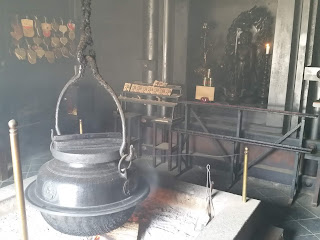Most people come to the island to visit the city of Miyajima and the famous floating torii that sits in its bay. I’m going to cover Miyajima on its own in another post later on, so for now, let’s focus on Daisho-in.
Before I go further though I need to take a moment to discuss the unique combination of religions that most Japanese people practice in everyday life. The religion indigenous to Japan is Shinto, which at its core is focused on nature, balance and the idea that the spirit of everything is interconnected. Buddhism came to Japan and once it got popular, there were efforts by the Japanese government to drive it out or at least repress it. The result ended up being a blending of the two religions. Right next to almost any Buddhist temple you visit in Japan, you'll find a Shinto shrine. Many people will worship at both at different times.
Shinto's afterlife is basically similar to Hades from Greek mythology. A tour guide once told me that the best way to explain why the Japanese tend to blend the two is to say that Buddhism offered "heaven" but didn't necessarily disregard all of the other Shinto beliefs, so people took what they wanted from both.
Heading up to the peak of Mt. Misen, you'll see a number of temples and shrines from both religions. They tend to dot different places along the path.
The first real step up to Daisho-in is easy if you don't mind heights. You can take a sky ride up to the first peak on the island which cuts a very large swath of literal mountain climbing out of the hike. From that point, there is no other way forward but to walk. It's a long trek downhill and then back uphill again to an adjoining peak. My wife and daughter bowed out along the way and told me they’d meet me back by the sky ride. I’m going to try not to over or understate the climb. It’s doable for anyone who's able-bodied. I had the wrong shoes and shirt on and was at least fifty pounds overweight at the time, but I made it. Take your time and you’ll be fine.
Along the way, you’ll be treated to some spectacular views
of the inland sea area of Japan. Other
than the paved path, everything around you is natural; no cars, no trains, no
hustle and bustle of life at all. Aside
from other hikers, it’s a pretty peaceful place.
When you get close, you’ll be able to see the edge of the temple above you. It gave me a second wind at that point and I was up in no time.
When you get close, you’ll be able to see the edge of the temple above you. It gave me a second wind at that point and I was up in no time.
When you finally do reach the temple, don’t be surprised to
find guys like this sitting around. It’s
become a tradition for some travelers to leave sunglasses, hats, etc. on the
statues here. The temple was founded on
Mt. Misen in the year 806 A.D. The
founder, a Buddhist monk named Kukai (or Kobo Daishi as he is now referred to after
death). Kukai ventured to the island
and after visiting the mountain decided to establish the temple and perform 100
days of “Kokuzou-Gumonji”. That is a secret doctrine in Japanese Buddhism and once he was finished, he began what would become a school of Buddhism that
survives in Japan to this day. It’s called Shingon Buddhism and it
translates into “True Words”.
During the time that Kukai was performing his 100 day ritual, he lit a fire. That same fire has been kept burning ever since. If you’re counting, that’s over 1,200 years. You can walk right up to it and see it for yourself. It’s housed in a building that’s called Reikado Hall (Eternal Fire Hall) and you can walk completely around it.
The smoke is fragrant and not for anyone even remotely asthmatic, however the pot above it contains water that is said to have many healing properties. I didn’t try it out myself so I can't vouch for it, but seeing this place in person was pretty fantastic. An interesting side note, the eternal flame at the Hiroshima Atomic Bomb Memorial was lit from a torch ignited in this fire.
If you want to visit another shrine, this one dedicated to the gods who protect the mountain, you can visit Sankido Hall. The main god is named Tsuichokijin and he is served by tengus which are long-nosed goblins from Japanese folklore. Tengus are some of my favorite creatures in Japanese mythology so this was a must see also, although I don't have any good pictures from it.
In fact, from that point I turned around and headed back to my family, however you can go even further if you wish. There are even more shrines along the way to the peak on the island. Had I been on my own, I’d have spent the entire day visiting them.
This is honestly one of the most beautiful settings I’ve ever been in, so don't miss the opportunity if you get to visit the area.
Next week, we'll wrap up the look at shrines, but this one is less about the shrine and more about the GIGANTIC party thrown there once a year. Swing by next week to see what I'm talking about.
Until then, visit my Amazon Author's page and I'll catch up with you next time!
Next week, we'll wrap up the look at shrines, but this one is less about the shrine and more about the GIGANTIC party thrown there once a year. Swing by next week to see what I'm talking about.
Until then, visit my Amazon Author's page and I'll catch up with you next time!










No comments:
Post a Comment